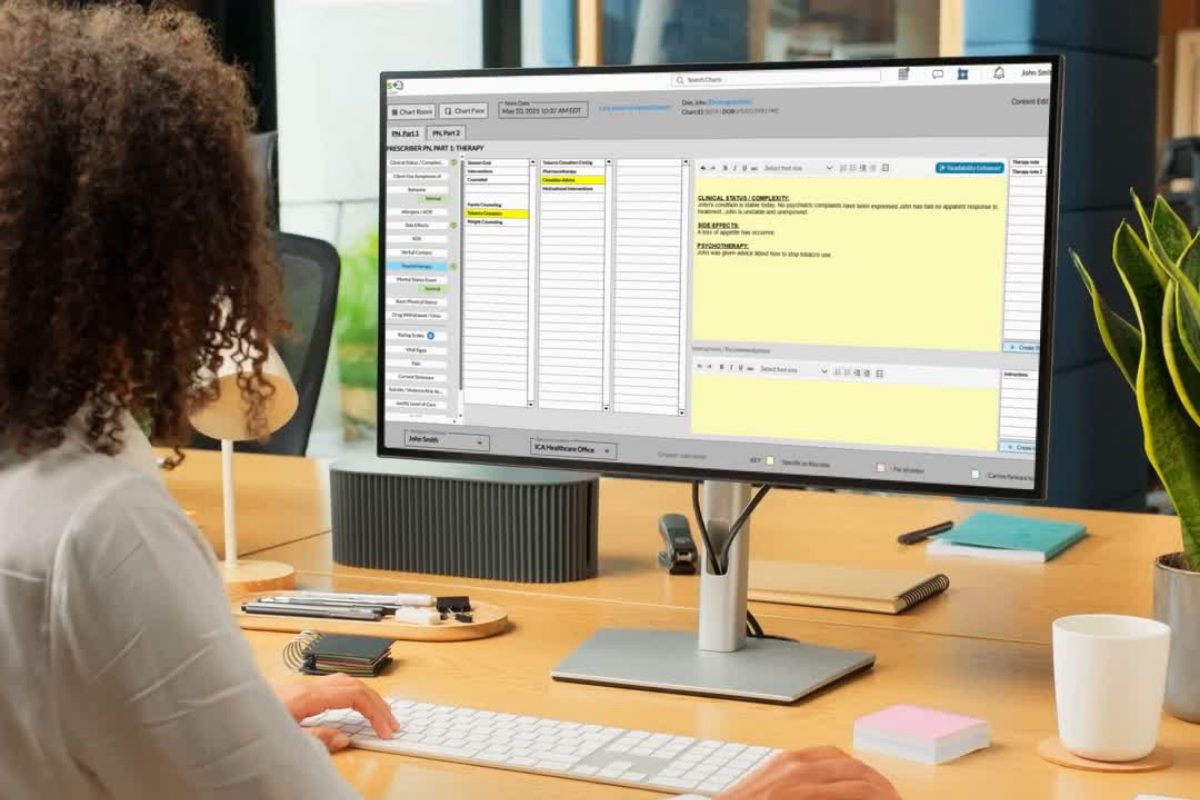Blog > Documentation > Mental Health Discharge Summary Sample
Mental Health Discharge Summary Sample: What "Good" Looks Like
In this post, we’ll walk through a realistic mental health discharge summary sample, break down the key components every plan should include, and highlight how using ICANotes can help clinicians streamline the discharge planning process without sacrificing quality or compliance.

Kaylee Kron, LMSW, GC-C
Last Updated: May 21, 2025

A well-structured discharge plan is essential for ensuring continuity of care and promoting positive long-term outcomes for clients transitioning out of mental health treatment. Whether you’re a therapist or a psychiatric provider, crafting a comprehensive, clear, and collaborative mental health discharge summary can make the difference between ongoing recovery and relapse or crisis.
Why Discharge Planning Matters in Mental Health Care
Mental health discharge planning is more than just an administrative task. It’s a therapeutic process that:
- Prepares the client for discharge from the beginning of care and provides a clear understanding of what treatment is working toward
- Reduces risk of relapse, readmission, or disengagement from care
- Provides clients with clear next steps for continued support
- Ensures that vital clinical information is shared with future providers
- Fulfills legal, ethical, and billing documentation requirements
For psychiatric discharges, this process is especially important when managing medications, follow-up care, or residual safety concerns.
Key Elements of a Strong Mental Health Discharge Summary Template
Whether you’re creating a mental health discharge summary for a psychiatric hospital discharge or ending outpatient therapy, here’s what your discharge summary must include:
✅ Client Information
Name, date of birth, diagnosis, dates of service, and type of care provided.
✅ Reason for Discharge
Include whether discharge was planned, voluntary, administrative, or due to goal completion.
✅ Summary of Treatment
A brief overview of treatment duration, type (e.g., CBT, DBT, medication management), and major clinical themes.
✅ Functional Status and Progress
Describe symptom changes, functional improvements, or persistent challenges.
✅ Medications and Medical Follow-Up
Include current medications, prescriber information, and instructions for follow-up appointments or lab work.
✅ Crisis or Safety Plan
Outline steps for managing future crises, including emergency contacts and crisis hotlines.
✅ Aftercare and Referrals
List specific next steps—such as ongoing therapy, psychiatry follow-up, case management, housing support, or substance use treatment.
✅ Client Participation
Document client input, agreement with the plan, and understanding of recommendations.
✅ Provider Contact Information
Include provider name, credentials, and a way for new clinicians to follow up if needed.
Want to make sure you never miss a step when discharging a client?
Download our Comprehensive Discharge Checklist for Mental Health Clinicians—a practical, printable tool designed to help therapists, counselors, and psychiatric providers ensure every discharge is ethical, complete, and clinically sound.
Mental Health Discharge Summary Example
Here’s a realistic sample of a mental health discharge summary for reference:
Client: Alex T.
DOB: 07/12/1992
Diagnosis: Major Depressive Disorder, Recurrent, Moderate
Reason for Discharge: Client completed treatment goals and reported improved functioning.
Summary of Treatment: 16 sessions of CBT, focused on cognitive restructuring, behavioral activation, and addressing social isolation.
Functional Status: Client reports resuming full-time work, improved mood, better sleep, and increased social engagement. PHQ-9 score reduced from 18 to 7.
Medications: Sertraline 100 mg/day prescribed by Dr. H. Liu. Refill provided. Next follow-up is scheduled for May 15.
Crisis Plan: In case of worsening symptoms, client will contact emergency services or National Suicide Prevention Lifeline (988).
Aftercare: Client referred to local mindfulness-based stress reduction group. Advised to schedule a check-in therapy session within 3 months.
Client Acknowledgment: Discharge plan reviewed with client on 04/10/2025. Client voiced understanding and agreement.
Provider: Jordan Martinez, LCSW
What Makes This a Good Mental Health Discharge Summary Example?
This example reflects best practices in mental health discharge planning because it:
- Clearly summarizes treatment outcomes in measurable, observable terms
- Includes follow-up and referral details, reducing gaps in care and providing a clear roadmap for next steps for the client
- Documents medication and prescriber information, supporting continuity
- Addresses client safety, including crisis plan instructions
- Engages the client in the planning process and documents their agreement
This is the kind of discharge plan that supports client autonomy, demonstrates clinical diligence, and protects both the client and the provider.
How ICANotes Simplifies Mental Health Discharge Planning
Creating a detailed, personalized mental health discharge summary doesn’t need to be a manual process. With ICANotes, clinicians can:
- Use built-in mental health discharge summary templates tailored to psychiatric and therapeutic workflows
- Auto-populate relevant data from prior documentation, reducing time spent copying notes
- Track medications, diagnoses, and progress metrics all in one place
- Document risk assessments and follow-up plans directly into the clinical record
- Export or print easy-to-understand discharge instructions for clients
Whether you’re managing discharge planning for psychiatric patients or outpatient therapy clients, ICANotes helps ensure that every transition is safe, efficient, and compliant.
Final Thoughts on Mental Health Discharge Summaries
Discharge isn’t the end, it’s a bridge between what your client has accomplished in treatment and the support they’ll need moving forward. A thoughtful, well-documented discharge plan lays the foundation for continued care and stability. With the right structure, collaborative communication, and smart tools like ICANotes, you can make the process faster, more consistent, and clinically sound.
Start Your 30-Day Free Trial
Experience the most intuitive, clinically robust EHR designed for behavioral health professionals, built to streamline documentation, improve compliance, and enhance patient care.
- Complete Notes in Minutes - Purpose-built for behavioral health charting
- Always Audit-Ready – Structured documentation that meets payer requirements
- Keep Your Schedule Full – Automated reminders reduce costly no-shows
- Engage Clients Seamlessly – Secure portal for forms, messages, and payments
- HIPAA-Compliant Telehealth built into your workflow
Complete Notes in Minutes – Purpose-built for behavioral health charting
Always Audit-Ready – Structured documentation that meets payer requirements
Keep Your Schedule Full – Automated reminders reduce costly no-shows
Engage Clients Seamlessly – Secure portal for forms, messages, and payments
HIPAA-Compliant Telehealth built into your workflow
Related Posts
Kaylee Kron, LMSW, GC-C, is a certified grief counselor with over a decade of experience. She has worked extensively in nonprofit hospice care, helping individuals navigate their grief journeys. As an author, speaker, and advocate, Kaylee brings a wealth of knowledge and compassion to her work, creating spaces for acknowledgment and healing.







